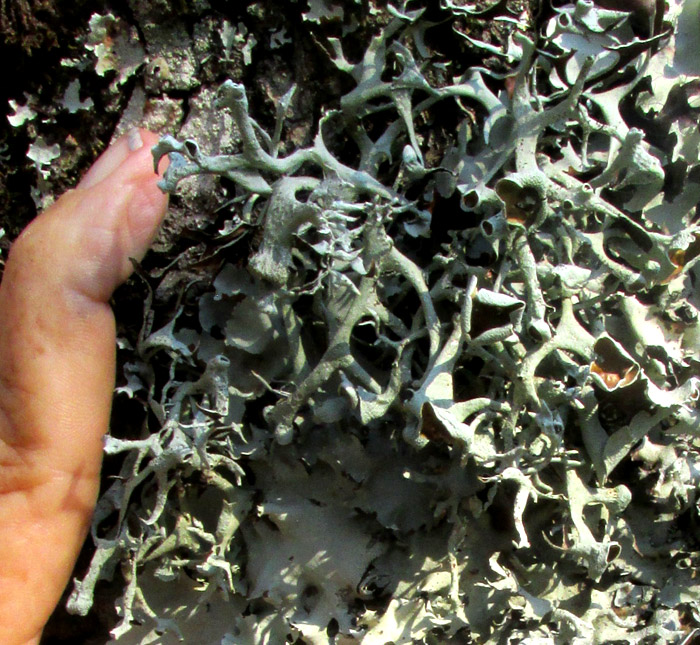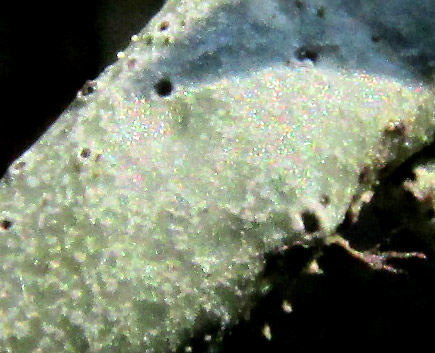Excerpts from Jim Conrad's
Naturalist Newsletter
Entry from field notes dated May 7, 2023, atop hill forested with pines and oaks about 1km east of Curva de la Doctorcilla, on unnamed road connecting Hwy120 and El Doctor; limestone bedrock; elevation ±2650m (8700 ft); Eastern Sierra Madre mountains of east-central Querétaro state, MÉXICO, (N20.88°, W99.62°)
COMMON ANTLER LICHEN
On a pine tree's bark at chest level the above lichen looked like a handful of curly, bleached lettuce plastered to the trunk. Here's a closer look:

Notice that instead of neat little "pixie-cup" apothecia held above a plane of doily-like thalli, they were irregularly formed, sometimes seeming to have arisen from two thalli. They varied greatly in size and their tops faced every direction. Seemingly randomly placed holes appeared on the thalli, and there were scattered tiny warty bumps, densely covering the surfaces of some thalli and almost absent on others. Sometimes the thalli were sheet-like but sometimes they thickened, looking like branching tubes. Sometimes the tubes opened widely along a side, as if a construction crew had forgotten to finish one side of a tunnel. Here's a closer look at a thallus's surface

The crater-like structures dispersed here and there over the surface are pycnidia, where the lichen's fungal component produces special kinds of asexually developed spores called pycnidiospores. The smaller, warty bumps are isidia, whose tops wear away forming dust-like particles consisting of algal or cyanobacteria cells enmeshed in fungal hyphae. If the particles land in a congenial environment, each one can form a new lichen body. In the lower, right corner, the slender tree-like item is a mystery. It looks as if a few strands of fungal hyphae have decided to explore the world on their own, without their photosynthesizing partners, but surely not.
Of the handful of lichens I know, this one reminded me most of the Forked Tube Lichen , in the genus Hypogymnia. However, no species in that genus looked like our pine-bark one, so a phylogenetic tree was sought indicating genera sharing immediate ancestors with Forked Tube Lichens. One closely related genus was Pseudevernia, a small one embracing only six species, but with taxa occurring in Mexico. Among images of Pseudevernia species occurring in our mountainous, central Mexican region,the species most commonly observed was PSEUDEVERNIA CONSOCIANS, often called the Common Antler Lichen, and those images best matched our pine-bark lichen.
Common Antler Lichens are described on LichenPortal.Org's Pseudevernia consocians page as occurring "...usually on conifers (especially pines) in open pine-oak forests," which is exactly right for us. The distribution map on the GBIF Pseudevernia consocians page indicates that the species mostly has been observed in eastern North America, except in the US Southeast, plus they appear in the Rocky Mountains, and throughout Mexico's uplands, with sporadic reports elsewhere in the world.
Most pictures of the species, predominantly taken in the US, give a general impression somewhat different from ours. Ours is strikingly curly-crispy, with numerous thalli wider than in most other pictures. However, also there are pictures of individuals perfectly matching ours.
The most recent work I can find dealing with antler lichens is Mason Hale, Jr.'s 1968 "A Synopsis of the Lichen Genus Pseudevernia." In plant taxonomy, 1968 seem like ancient history, so it wouldn't be surprising if some quirky looking lichens thought of as Pseudevernia consocians are overlooked species.
Common Antler Lichen is very similar to another antler-type lichen appearing in our area, Pseudevernia intensa. The main visible feature separating the two species is that our Pseudevernia consocians bears wartlike isidia, often very conspicously, while Pseudevernia intensa doesn't. Some of our individual's thalli bore numerous isidia, but some had very few.
By the way, the algal species partner in Common Antler Lichen's otherwise fungal body is the green alga known as Trebouxia jamesii.
In Mexico, the 2002 study by A. Montoya and others entitled "Comparative ethnomycological survey of three localities from La Malinche Vulcano, Mexico" report that Common Antler Lichen has been used as a treatment for heart conditions among the Náhua and mestizo communities of Tlaxcala state. In the 2012 study of C. Illana-Esteban entitled "Líquenes Usados en Medicina Tradicional" it's documented that our Pseudevernia consocians is among five lichen species in the vicinity of Pátzcuaro, Michoacán eaten by the Purépecha people boiled with salt, to cure respiratory problems.